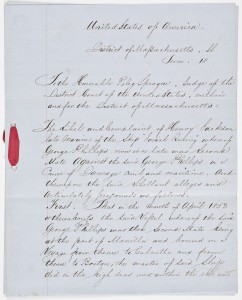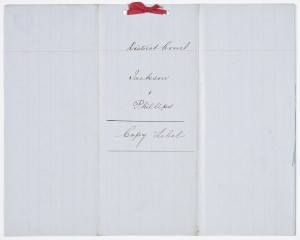Although we’re not often thought of as a legal repository, we do have a few famous firsts to claim in the realm of legal research. In our manuscript collection lives the notebook of Thomas Lechford, 1638-1641, the first lawyer in Boston. AAS was also the first government documents repository. In 1814, in an effort to make the Society a “respectable…national institution”, Isaiah Thomas urged all members of the Society to petition the federal government to “send the laws of the national government to be deposited and preserved in our library.” AAS thus became the first repository library for government documents in the United States, aside from the Library of Congress. Although we do not receive nearly as large a percentage today as we did in the 19th century, our collection of government documents still grows with select items each year.
 But one of our most interesting legal documents resides in our manuscripts collection, in the form of the papers of Richard Henry Dana, Jr. Dana was a lawyer by profession, but spent time at sea, and incorporated his experiences into his work as a lawyer, frequently representing seamen, and even publishing the book The Seaman’s Friend, a manual of general and legal advice for sailors, in addition to his more famous Two Years before the Mast. (For more about Dana, check out this blog post about his time at sea.) Dana argued notable cases, including defending several men accused of helping rescue a runaway slave in 1851, and also, unfortunately unsuccessfully, arguing for the release of Anthony Burns, another runaway slave, in 1854. (Dana’s file on the Burns case did not come to AAS with his other legal papers.) The AAS collection includes files from more than six hundred of his cases over the course of almost 35 years. Included are Dana’s notes, statements of witnesses, depositions, summonses, and correspondence related to each case. But what are most eye-catching about Dana’s collection of legal material are his piles of blue paper, tied together at the edges with red tape. That’s right – a metaphor come to life!
But one of our most interesting legal documents resides in our manuscripts collection, in the form of the papers of Richard Henry Dana, Jr. Dana was a lawyer by profession, but spent time at sea, and incorporated his experiences into his work as a lawyer, frequently representing seamen, and even publishing the book The Seaman’s Friend, a manual of general and legal advice for sailors, in addition to his more famous Two Years before the Mast. (For more about Dana, check out this blog post about his time at sea.) Dana argued notable cases, including defending several men accused of helping rescue a runaway slave in 1851, and also, unfortunately unsuccessfully, arguing for the release of Anthony Burns, another runaway slave, in 1854. (Dana’s file on the Burns case did not come to AAS with his other legal papers.) The AAS collection includes files from more than six hundred of his cases over the course of almost 35 years. Included are Dana’s notes, statements of witnesses, depositions, summonses, and correspondence related to each case. But what are most eye-catching about Dana’s collection of legal material are his piles of blue paper, tied together at the edges with red tape. That’s right – a metaphor come to life!
 As with many metaphors in the English language, the origin of the term “red tape” is obscure, and has multiple eras claiming its origin. Whether the term originated in the 16th-century Vatican, the Spanish Empire, or with Charles Dickens, we are all familiar with the phrase, and know that red tape refers to the bureaucratic hindrances that prevent action or decision making. In more recent history, American Civil War veterans’ records are known to have been bound in red tape, and here in our own collections, Richard Henry Dana bound his own legal material in red tape.
As with many metaphors in the English language, the origin of the term “red tape” is obscure, and has multiple eras claiming its origin. Whether the term originated in the 16th-century Vatican, the Spanish Empire, or with Charles Dickens, we are all familiar with the phrase, and know that red tape refers to the bureaucratic hindrances that prevent action or decision making. In more recent history, American Civil War veterans’ records are known to have been bound in red tape, and here in our own collections, Richard Henry Dana bound his own legal material in red tape.
While we always strive to find material and promote our collections for their context and research value, once in a while our collections find a way to make their intrinsic value known.
